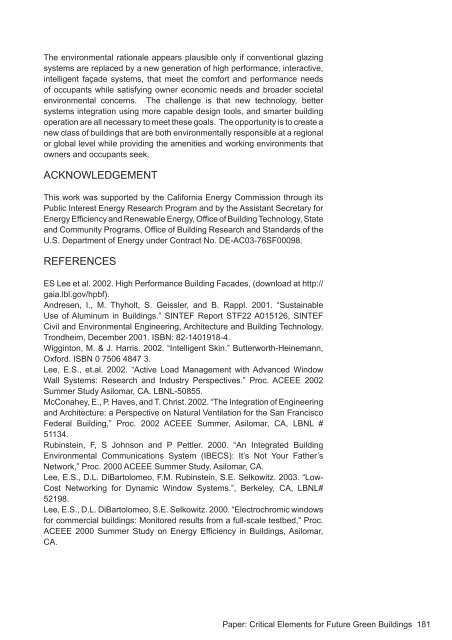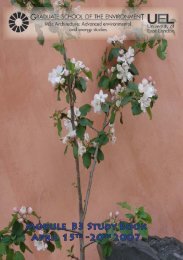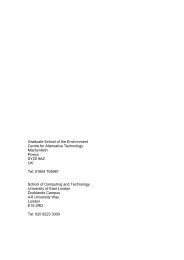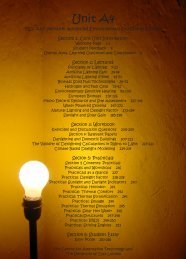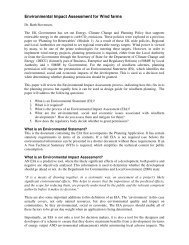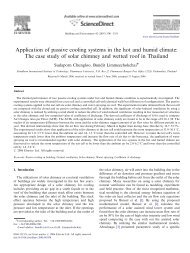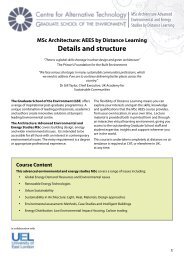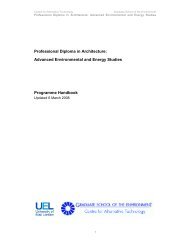Module B1 Study Book - the Graduate School of the Environment
Module B1 Study Book - the Graduate School of the Environment
Module B1 Study Book - the Graduate School of the Environment
Create successful ePaper yourself
Turn your PDF publications into a flip-book with our unique Google optimized e-Paper software.
The environmental rationale appears plausible only if conventional glazing<br />
systems are replaced by a new generation <strong>of</strong> high performance, interactive,<br />
intelligent façade systems, that meet <strong>the</strong> comfort and performance needs<br />
<strong>of</strong> occupants while satisfying owner economic needs and broader societal<br />
environmental concerns. The challenge is that new technology, better<br />
systems integration using more capable design tools, and smarter building<br />
operation are all necessary to meet <strong>the</strong>se goals. The opportunity is to create a<br />
new class <strong>of</strong> buildings that are both environmentally responsible at a regional<br />
or global level while providing <strong>the</strong> amenities and working environments that<br />
owners and occupants seek.<br />
ACKNOWLEDGEMENT<br />
This work was supported by <strong>the</strong> California Energy Commission through its<br />
Public Interest Energy Research Program and by <strong>the</strong> Assistant Secretary for<br />
Energy Efficiency and Renewable Energy, Office <strong>of</strong> Building Technology, State<br />
and Community Programs, Office <strong>of</strong> Building Research and Standards <strong>of</strong> <strong>the</strong><br />
U.S. Department <strong>of</strong> Energy under Contract No. DE-AC03-76SF00098.<br />
REFERENCES<br />
ES Lee et al. 2002. High Performance Building Facades, (download at http://<br />
gaia.lbl.gov/hpbf).<br />
Andresen, I., M. Thyholt, S. Geissler, and B. Rappl. 2001. “Sustainable<br />
Use <strong>of</strong> Aluminum in Buildings.” SINTEF Report STF22 A015126, SINTEF<br />
Civil and <strong>Environment</strong>al Engineering, Architecture and Building Technology,<br />
Trondheim, December 2001. ISBN: 82-1401918-4.<br />
Wigginton, M. & J. Harris. 2002. “Intelligent Skin.” Butterworth-Heinemann,<br />
Oxford. ISBN 0 7506 4847 3.<br />
Lee, E.S., et.al. 2002. “Active Load Management with Advanced Window<br />
Wall Systems: Research and Industry Perspectives.” Proc. ACEEE 2002<br />
Summer <strong>Study</strong> Asilomar, CA. LBNL-50855.<br />
McConahey, E., P. Haves, and T. Christ. 2002. “The Integration <strong>of</strong> Engineering<br />
and Architecture: a Perspective on Natural Ventilation for <strong>the</strong> San Francisco<br />
Federal Building,” Proc. 2002 ACEEE Summer, Asilomar, CA, LBNL #<br />
51134.<br />
Rubinstein, F, S Johnson and P Pettler. 2000. “An Integrated Building<br />
<strong>Environment</strong>al Communications System (IBECS): It’s Not Your Fa<strong>the</strong>r’s<br />
Network,” Proc. 2000 ACEEE Summer <strong>Study</strong>, Asilomar, CA.<br />
Lee, E.S., D.L. DiBartolomeo, F.M. Rubinstein, S.E. Selkowitz. 2003. “Low-<br />
Cost Networking for Dynamic Window Systems.”, Berkeley, CA, LBNL#<br />
52198.<br />
Lee, E.S., D.L. DiBartolomeo, S.E. Selkowitz. 2000. “Electrochromic windows<br />
for commercial buildings: Monitored results from a full-scale testbed,” Proc.<br />
ACEEE 2000 Summer <strong>Study</strong> on Energy Efficiency in Buildings, Asilomar,<br />
CA.<br />
Paper: Critical Elements for Future Green Buildings 181


